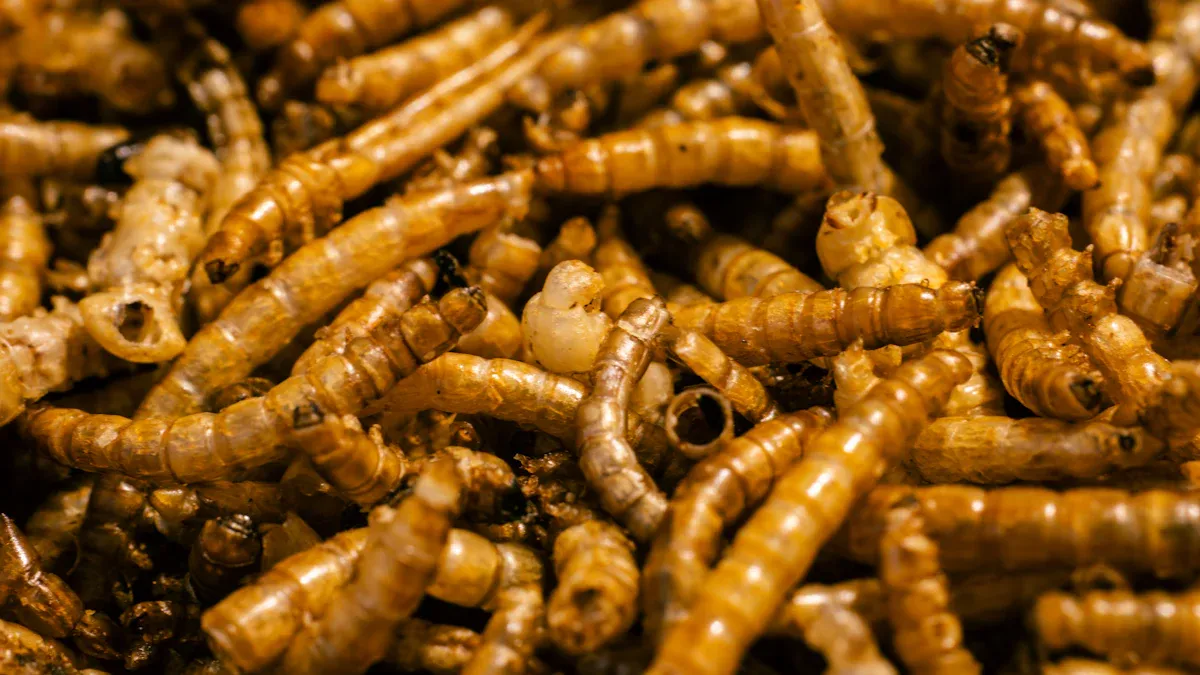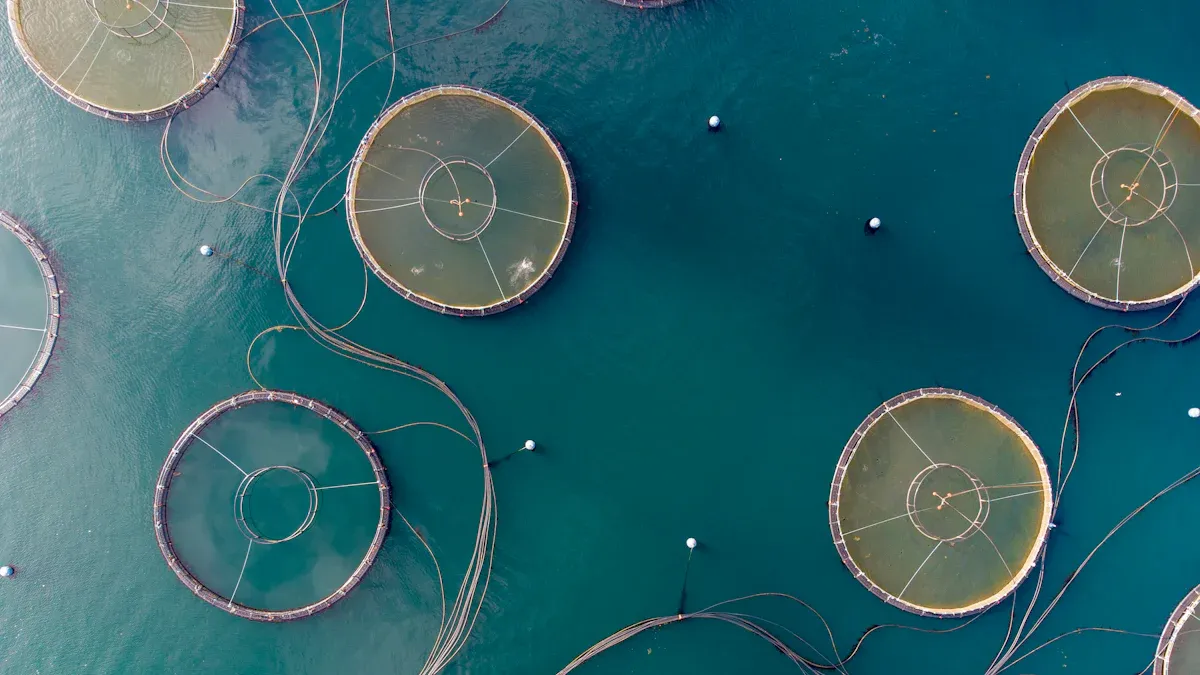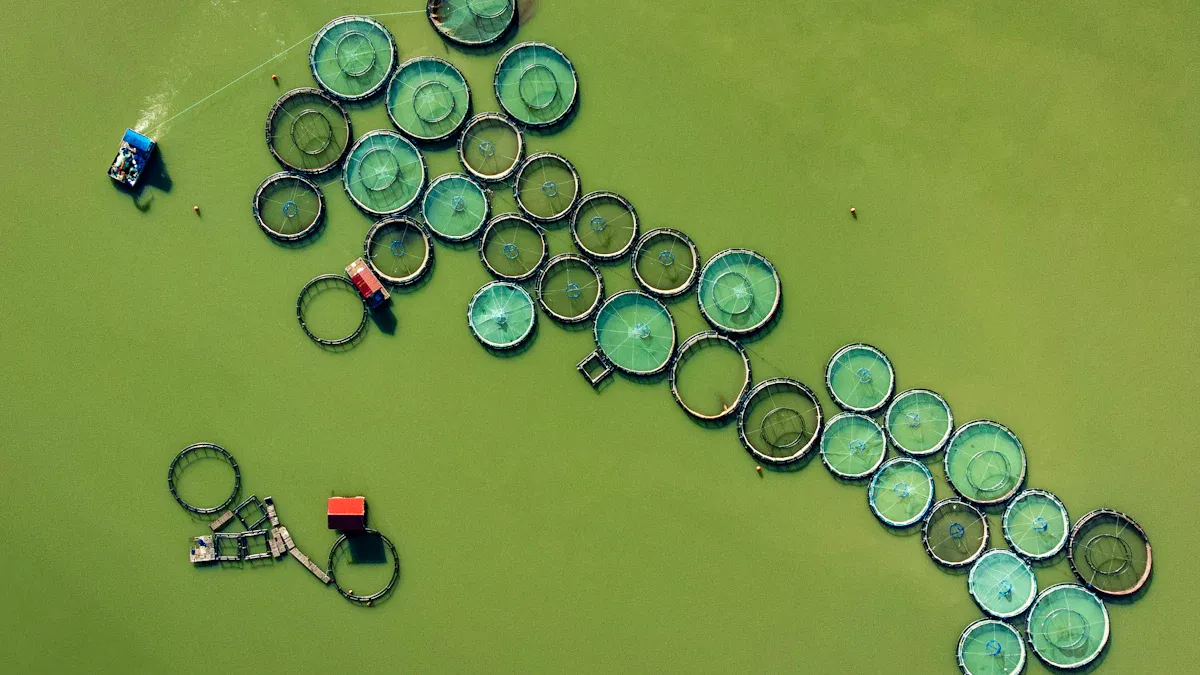
Sustainability in aquaculture isn’t just a buzzword—it’s a necessity. As fish farms grow, so does the demand for eco-friendly solutions. Traditional fishmeal relies heavily on wild-caught fish, which harms marine ecosystems. That’s where mealworm products come in. A growing market for insect-based feeds, like Dried Chubby Mealworms, offers a sustainable protein source. By reducing reliance on fishmeal, you can lower your farm’s environmental footprint while improving fish health. Partnering with a reliable mealworm supplier ensures you’re contributing to a greener future.
Key Takeaways
- Using Dried Chubby Mealworms can lower your farm’s harm to nature. They need less water and space than regular fishmeal.
- Adding mealworms to fish feed helps fish grow healthier and faster. It also cuts feed costs. Replace 20-30% of fishmeal with mealworms to start.
- Growing mealworms locally can make jobs and cut down on imports. This helps the environment and keeps your farm’s feed supply steady.
Key Challenges in Middle Eastern Fish Farming
Environmental Impact of Fishmeal Dependency
Fishmeal dependency creates serious environmental problems. Overfishing to produce fishmeal disrupts marine ecosystems and reduces biodiversity. This practice depletes essential fish populations, harming the balance of aquatic life. You might not realize it, but relying on wild-caught fish stocks for feed contributes to significant environmental degradation. By continuing this trend, fish farms risk damaging the very ecosystems they depend on.
🌍 Did you know? Overfishing for fishmeal not only affects marine life but also threatens the long-term sustainability of aquaculture.
Rising Feed Costs in the Region
Feed costs are skyrocketing in the Middle East. The fish feed market is expected to grow from $20.12 billion in 2023 to $31.72 billion by 2030, with a compound annual growth rate of 6.72%. This growth comes with challenges. Price volatility in key ingredients like fish oil, corn, and soybean often leads to higher costs. Supply chain disruptions and geopolitical factors make the situation worse. As a fish farmer, you’ve probably felt the pinch of these rising expenses.
- Fluctuating raw material prices directly impact feed costs.
- Increased demand for fish feed drives up prices even further.
- Supply chain issues can cause sudden price hikes, leaving farmers struggling to keep up.
Water Scarcity and Resource Management
Water scarcity is a pressing issue for fish farms in the Middle East. In Egypt, each person has access to just over 500 cubic meters of freshwater annually—half the amount needed for basic needs. Saudi Arabia faces even tougher challenges. Only 5% of its land is arable due to desertification and water shortages. Agriculture consumes nearly 80% of the country’s freshwater, leaving little for other uses.
- Growing populations increase water demand, worsening scarcity.
- Limited freshwater resources make sustainable fish farming harder to achieve.
Without better resource management, water scarcity could threaten the future of aquaculture in the region.
Benefits of Using Dried Chubby Mealworms in Aquaculture

High Protein Content and Nutritional Advantages
When it comes to nutrition, Dried Chubby Mealworms are a game-changer for aquaculture. They pack a punch with their high protein content—53%, to be exact. That’s more than what you’d find in beef or soybeans. Plus, they offer a complete profile of essential amino acids, which means your fish get all the nutrients they need without requiring additional supplements.
Here’s a quick comparison to show how mealworms stack up:
| Nutritional Aspect | Chubby Dried Mealworms | Beef | Soybeans |
|---|---|---|---|
| Protein Content | 53% | Lower than mealworms | Lower than mealworms |
| Protein-to-Fat Ratio | Higher | Lower | N/A |
| Essential Amino Acids | Complete | Incomplete | Requires pairing |
| Water Requirement (liters) | 1,700 | 15,000 – 20,000 | N/A |
| Carbon Footprint | 1% of beef protein | Higher | N/A |
By switching to mealworms, you’re not just improving fish health—you’re also making a smarter, more sustainable choice.
Lower Carbon Footprint Compared to Fishmeal
Did you know that producing Dried Chubby Mealworms generates a fraction of the carbon emissions compared to traditional fishmeal or livestock feed? Mealworms require minimal resources to grow. They consume less water and land, and they produce fewer greenhouse gases. This makes them an eco-friendly alternative for fish farms looking to reduce their environmental impact.
By incorporating mealworms into your feed, you’re taking a big step toward lowering your farm’s carbon footprint. It’s a win-win for your business and the planet.
Efficient Use of Land and Water Resources
One of the best things about mealworms is how efficiently they use resources. Unlike traditional livestock, mealworms don’t need large areas of land or massive amounts of water. They’re easy to breed and have a high reproductive rate, with each female laying 400-500 eggs. This means you can produce a lot of protein in a small space.
Here’s why mealworms are a sustainable choice:
- They require significantly less land and water compared to livestock.
- Their quick incubation period (4-34 days) ensures fast production cycles.
- They’re scalable, making them a reliable option for regions facing resource scarcity.
By choosing mealworms, you’re not just feeding your fish—you’re conserving precious resources and contributing to a more sustainable future.
Practical Applications of Dried Chubby Mealworms in Fish Farms

Case Studies of Successful Adoption
Fish farms worldwide are already reaping the benefits of Dried Chubby Mealworms. In one notable case, a tilapia farm in Egypt replaced 30% of its traditional fishmeal with mealworms. The results were impressive. The fish showed faster growth rates and better overall health. Farmers also noticed a reduction in feed costs, which helped improve their profit margins.
Another example comes from a trout farm in Jordan. By incorporating mealworms into their feed, they reduced their reliance on imported fishmeal. This change not only cut costs but also lowered the farm’s carbon footprint. These success stories highlight how mealworms can transform aquaculture operations.
🐟 Tip: Start small by replacing a portion of your feed with mealworms. Gradually increase the percentage as you see results.
Integration into Existing Aquaculture Systems
Adding Dried Chubby Mealworms to your current setup is easier than you might think. Leading feed producers are already shifting toward sustainable options like insect meals. Mealworms are rich in protein, healthy fats, and essential amino acids, making them an ideal choice for fish feed.
Here’s why they fit seamlessly into your system:
- They enhance growth rates and feed efficiency.
- They reduce the environmental impact of your farm.
- They’re compatible with most existing feed formulations.
By integrating mealworms, you’re not just feeding your fish—you’re future-proofing your farm.
Opportunities for Localized Production
The Middle East has a unique opportunity to produce mealworms locally. Mealworms require minimal land and water, making them perfect for arid regions. Setting up a local production facility can reduce dependency on imports and create jobs in your community.
Imagine the possibilities. You could grow your own supply of Dried Chubby Mealworms, cutting costs and ensuring a steady feed source. Localized production also supports sustainability by reducing transportation emissions. It’s a win for your farm and the environment.
Overcoming Challenges in Scaling Mealworm Products
Addressing Cost and Scalability Issues
Scaling up mealworm production comes with financial hurdles. High production costs and slow consumer adoption have made it tough for producers to expand. For example, major companies like Ÿnsect have faced financial struggles despite significant investments. However, there’s good news. The mealworm market is growing rapidly, with projections showing an increase from USD 9.29 million in 2023 to USD 17.66 million by 2031. This growth, driven by a 7.4% annual increase, highlights the rising demand for mealworm products.
To tackle costs, advancements in farming technologies and processing methods are key. These innovations can improve efficiency, reduce expenses, and make mealworm farming more scalable. By adopting these strategies, you can position your farm to meet the growing market demand while keeping costs under control.
Navigating Regulatory and Market Barriers
Regulatory delays and market resistance are significant obstacles. In Europe, cultural perceptions have slowed the acceptance of insect-based feeds, even though younger consumers are showing more interest. Lengthy approval processes also discourage investment. For instance, the European Food Safety Authority took years to approve yellow mealworms as a novel food, and further approvals remain slow.
Despite these challenges, the tide is turning. As awareness of sustainable practices grows, more markets are opening up to insect-based feeds. By staying informed about regulatory changes and aligning your practices with global standards, you can overcome these barriers and tap into new opportunities.
Educating Farmers on the Benefits of Mealworm Feed
Education plays a crucial role in promoting mealworm feed. Studies show that farmers with higher education levels are more likely to adopt alternative protein sources like yellow mealworms. When farmers understand the nutritional and environmental benefits, they’re more willing to make the switch.
You can start by attending workshops or training sessions that highlight the advantages of mealworm feed. These programs can help you see how mealworms improve fish health, reduce costs, and support sustainability. By spreading awareness, you’re not just helping your farm—you’re contributing to a broader shift toward eco-friendly aquaculture.
Dried Chubby Mealworms are a game-changer for sustainable aquaculture. They deliver 53% protein, healthy omega-3 and omega-6 fats, and require far fewer resources than traditional feed options. Producing them uses only 1,700 liters of water per kilogram, compared to 15,000 liters for beef. Their minimal carbon footprint makes them perfect for eco-conscious fish farms.
By adopting mealworm-based solutions, you can improve fish health, cut costs, and reduce your environmental impact. It’s time to embrace this innovative feed and lead the way toward a sustainable future in Middle Eastern aquaculture.
FAQ
What makes mealworms better than traditional fishmeal?
Mealworms offer 53% protein, essential amino acids, and a lower carbon footprint. They’re eco-friendly, cost-effective, and improve fish health. 🐟
Can mealworms replace all fishmeal in aquaculture?
Not entirely. Start by replacing 20-30% of fishmeal with mealworms. Gradually increase as you monitor fish growth and health.
Are mealworms safe for fish?
Yes! Mealworms are natural, nutrient-rich, and free from harmful additives. They’re a healthy, sustainable choice for your fish farm.


